In this article, you’ll learn about what is engine valves and how they work in an engine. Valve mechanism and cooling of a valve. You can download the PDF file of this article at the end.
What is Engine Valves?
A valve is a device to close and open a passage. Engine valves are devices that are used in internal combustion engines to allow or stop the flow of fluid or gas from cylinders or combustion chambers during the engine while the engine is operating.
These are also known as check valves which are used for air injection in vehicles as part of emission control and exhaust gas recirculation systems. Engine valves are commonly employed in every type of combustion engine such as gasoline, diesel, kerosene, natural gas, or propane.
In motor vehicle engines, two engine valves are used for each cylinder-an inlet (or intake) valve and an exhaust valve. So, this article helps you to understand the different types of engine valves along with their functions and operation in combustion engines.
Inlet Valve
Fuel is allowed to the cylinder by the inlet valve. When closed, the valve seals the combustion space tightly. The valves are usually made of austenitic stainless steel which is a corrosion and heat-resisting material. Inlet valve is subjected to less heat is usually made of nickel-chromium alloy steel.
Exhaust Valve
The burned gases escape by the exhaust valve. The exhaust valve is usually made of silichrome steel which is an alloy of silicon and chromium with unusual resistance to heat.
The valves used in car engines are termed poppet or mushroom valves. The head of the valve has an accurately ground face with enough margin left to avoid a thin edge.
The angular face is ground on the valve head to make an angle of 45° or 30° to match the angle of the valve seat in the cylinder head. Spring retainer lock grooves are provided at the end of the valve stem.
Read also: List of Car Engine Parts: Its Function (With Pictures)
Types of Engine Valves
There are 3 different types of engine valves as follows:
- Poppet valve
- Sleeve valve
- Rotary valve
- Reed valve
#1 Poppet Valve
It is also known as a mushroom valve because of its shape. It is used to control the timing and quantity of gas flow into an engine. This is the most widely used valve in an automobile engine. The poppet valve is given the name because of its motion of popping up and down.

It consists of a head and a stem. The valve face usually with an angle of 30° to 45° is ground perfectly, since it has to match with the valve seat for perfect sealing.
The stem has a spring retainer lock groove and its end is in contact with the cam for up & down movements of a valve. In exhaust, a pressure differential helps to seal the valve. In intake valves, the pressure differential helps open them.
#2 Sleeve Valve
The sleeve valve as the name implies is a tube or sleeve that fits between the piston and the cylinder wall in the cylinder of an internal combustion engine, where it rotates/slides.
Ports on the side of the sleeves come into alignment with the cylinder’s inlet and exhaust ports at the appropriate stages in the engine’s cycle.
The inner surface of the sleeve forms the inner cylinder barrel in which the piston slides. The sleeve is in continuous motion allowing and driving out the gases by virtue of the periodic coincidence of port cut in the sleeve with ports formed through the main cylinder casting.
Advantages
- These valves are simple in construction and are silent in operation.
- There is noise because there are no noise-making parts like valve cams, rocker arm, tappets valves, etc.
- Sleeve valve has less tendency of detonation. Cooling is very effective as the valve is in contact with water jackets.
#3 Rotary Valve
There are many types of rotary valves. The figure shows the disc-type rotary valve. It consists of a rotating disc that has a port. While rotating, it communicates alternately with the inlet and exhaust manifolds.
Advantages
- Rotary valves are simple in construction and are manufactured at cheaper costs.
- They are suitable for high-speed engines.
- These valves have fewer stresses and vibrations.
- Rotary calves perform smooth, uniform, and noise-free operations.
#4 Reed Valve
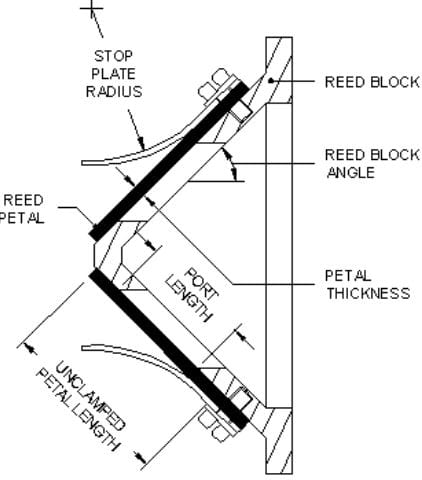
These are a type of check valve that opens and close the flow of fluid in the same direction under varying pressure on each face. It is consists of a mechanical bar hinged at one end that covers the passage and allows air or charge to flow in only one direction.
This valve is placed such that the suction pressure opens the inlet valve and closes the exhaust valve. And the exhaust pressure closes the inlet valve and opens the exhaust valve. These are usually installed in two-stroke engines.
Read Also: What is the function of Crankshaft? Parts, Types, Uses [PDF]
Types of Engine Valve Mechanisms
The valves are operated by cams mounted on a camshaft. The camshaft gets motion from the crankshaft. As the camshaft turns, the cam operates the valve.
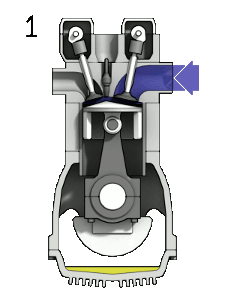
According to the location of the valves, the valve mechanism is of two types:
- Valve mechanism for operating the valve in engine block (straight poppet valve).
- Valve mechanism for operating the valve in the cylinder head (overhead poppet valve).
Valve-Tappet Clearance
A slight clearance is kept between the valve tappet and the valve stem in the case of the straight poppet valve, and between the rocker arm and valve stem in the case of the overhead poppet valve. This is known as valve tappet clearance, and sometimes as valve lash. This clearance allows for expansion of the valve stem as the engine becomes heated.
If sufficient clearance is not given, the valve will not seat properly when the engine becomes heat, which will cause power loss and lifting of the valve. It is better to have more clearance than necessary rather than to have too little, in spite of the slight increase in noise of the valve mechanism.
The valve-tappet clearance depends upon the following factors:
- Length of the valve stem
- The material of the valve.
- The temperature at which the engine operates.
Hydraulic Valve Lifter
It is very quiet in operation because it ensures zero valve tappet clearance. It automatically adjusts its length to compensate for differences in the valve. tappet clearance. Also, it usually requires no adjustment in normal service.
Its body consists of a cylinder and an oil reservoir. An opening in the body is connected with an oil pressure line from the engine lubricating system to supply the reservoir with oil. A plunger fits inside the cylinder so that its upper end contacts the bottom of the pushrod, and its lower end is supported by oil between it and the bottom of the cylinder.
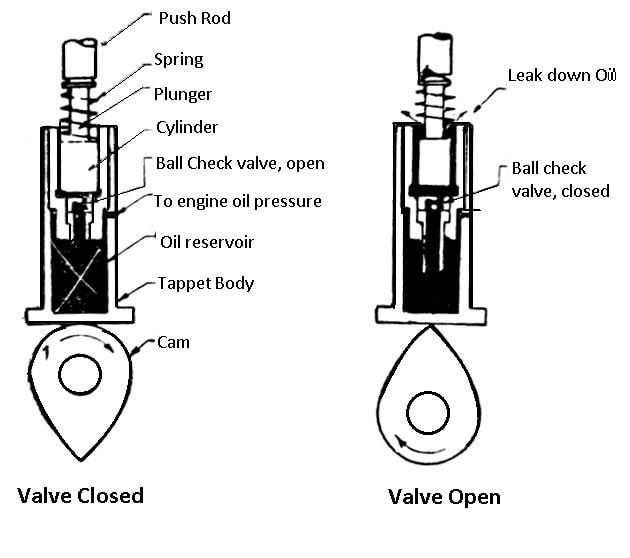
When the valve is closed as at (a) (cam on the lower side), oil from the reservoir opens the ball-check valve and raises the plunger by passing between it and the cylinder bottom. This produces zero clearance between the lifter unit and push rod, and between the rocker arm and valve stem.
When the cam turns to lift the lifter as at (b) (cam on the upside). The ball-check valve closes to prevent the return of oil to the reservoir and causes the entire lifter unit to lift the pushrod to open the valve. Because the lift starts with zero clearance, the noise is reduced to a minimum.
As shown at (b) during the lifting operation, a certain amount of oil is allowed to leak between the plunger and the cylinder, which causes lowering of a plunger to produce clearance if the spring did not raise it again when the pressure on the plunger is relieved by the closing of the engine valve. This reopens the ball check valve, oil again comes beneath the plunger and the lifter is again set for zero clearance.
Read Also: What is Piston Pin? Working, Types, Parts, Advantages [PDF]
Eccentric Rocker Arm
The eccentric rocker arm automatically compensates for the difference in valve-tappet clearance. It consists of a conventional rocker arm modified to hold an eccentric by means of a slot and pin.
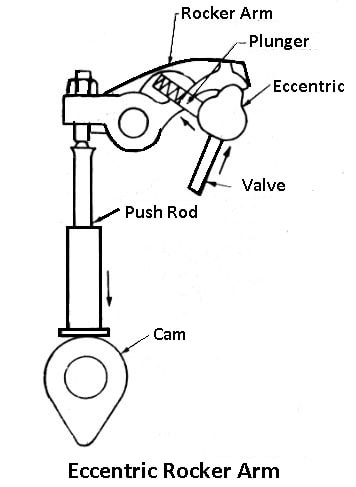
The plunger and spring control the piston of an eccentric. The plunger is activated by the spring and by oil pressure from an orifice in the rocker arm.
When the engine valve is closed (cam on the low side), the eccentric under the action of spring and plunger moves to take up any clearance, in the valve operating the train. As the cam rotates to open the valve, the plunger and spring absorb any shock produced by this movement. When the cam is on the upside, the valve is completely open.
Valve Cooling
It is obvious that the exhaust valve runs hotter than the inlet valve because the exhaust valve is always in contact with the hot gases while the inlet valve is somewhat cooled by the incoming fresh charge. The exhaust valve may actually become red hot during a short period of operation. The valve face is hottest and the valve stem is the coolest part of a valve.
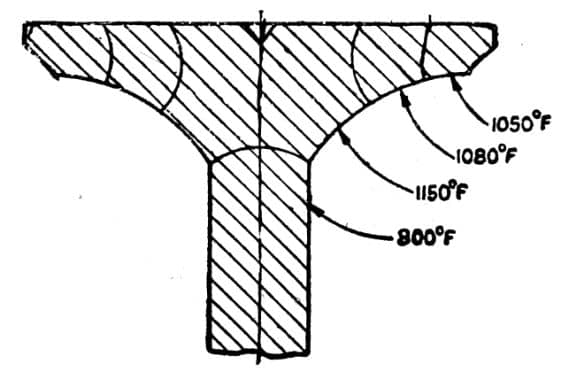
The valve stem passes heat to the valve guide and the valve face passes heat to the valve seat, and this helps to keep the valve cool. To provide adequate cooling, the cylinder head must be designed so as to permit good water circulation around the critical areas of the valve.
If the valve face fits properly on the valve seat and completely closes the combustion chamber, there will be no loss of compression and power.
In spite of this, the proper valve seating also provides full face contact with the valve seat through which more heat transfer can take place. Uneven contact may cause a valve to run several hundred degrees hotter than normal, which will shorten the valve life.
Sodium Cooled Valve
In many heavy-duty engines, sodium-cooled valves are used. A sodium-cooled valve has a hollow stem, which is partly filled with metallic sodium. Sodium melts at 97’5°C.
Thus, at operating temperatures the sodium is liquid. When the engine is running, the valve moves up and down, the sodium is thrown upward into the hotter part of the valve.
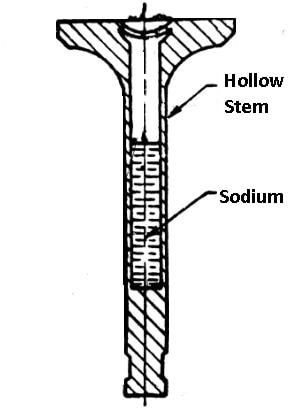
It absorbs heat, which is then given up to the cooler stem as it falls down in the stem again. This action keeps the valve head cool.
Sodium cooled valve runs as much as 100°C cooler than a solid stem valve of similar design under the same operating conditions. This means a sodium-cooled valve has a longer life. But its use requires more care.
If the hollow stem of the sodium-cooled valve is cracked or broken, it is potentially dangerous. Sodium bursts into flame in contact with water. It causes a deep and serious burn on the skin, As long as sodium is safely in the valve stem, there is no danger.
Conclustion
That’s it, thanks for reading. If you have any questions or doubts about “Engine Valves” tell us in the comments. Share this article with your friends if it’s worth sharing.
Want free PDFs sitting at home? Then subscribe to your newsletter.
Download PDF of this article:
Read next:
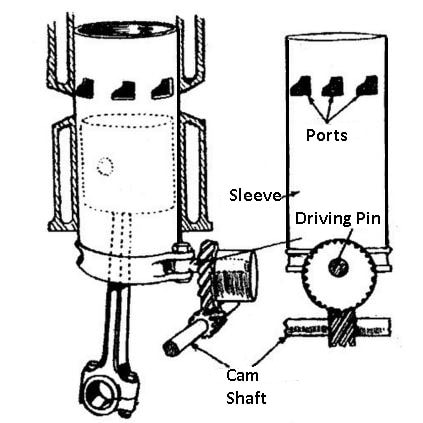
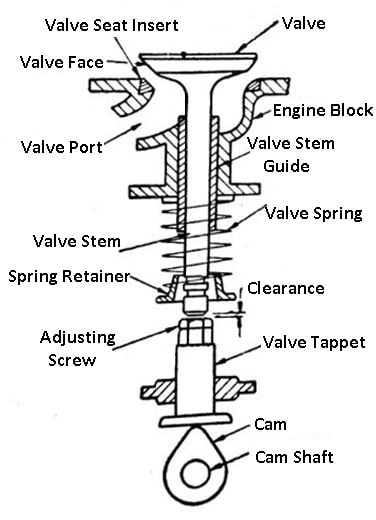
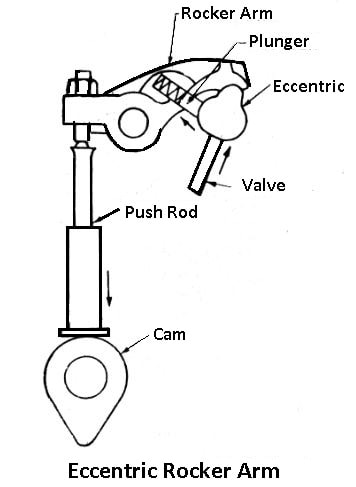
Very interesting pdf as they are helpful in explaining different aspects of whatever mechanical topics you are curious about.
Thank you for your kindness in sharing the tools to learn several things.
Looking forward to receiving the pdf files I has asked to receive.
All mechanical articles helping to understand how they are designed and manufactured.
Great job!
Thanks for your valuable feedback. I’m glad it was helpful for you.
Bhut achi jankari di hai bhai ji aap ne
Thank you.
Great Blog
Thank you so much 🙂
It helpful thank you.
You’re welcome 🙂